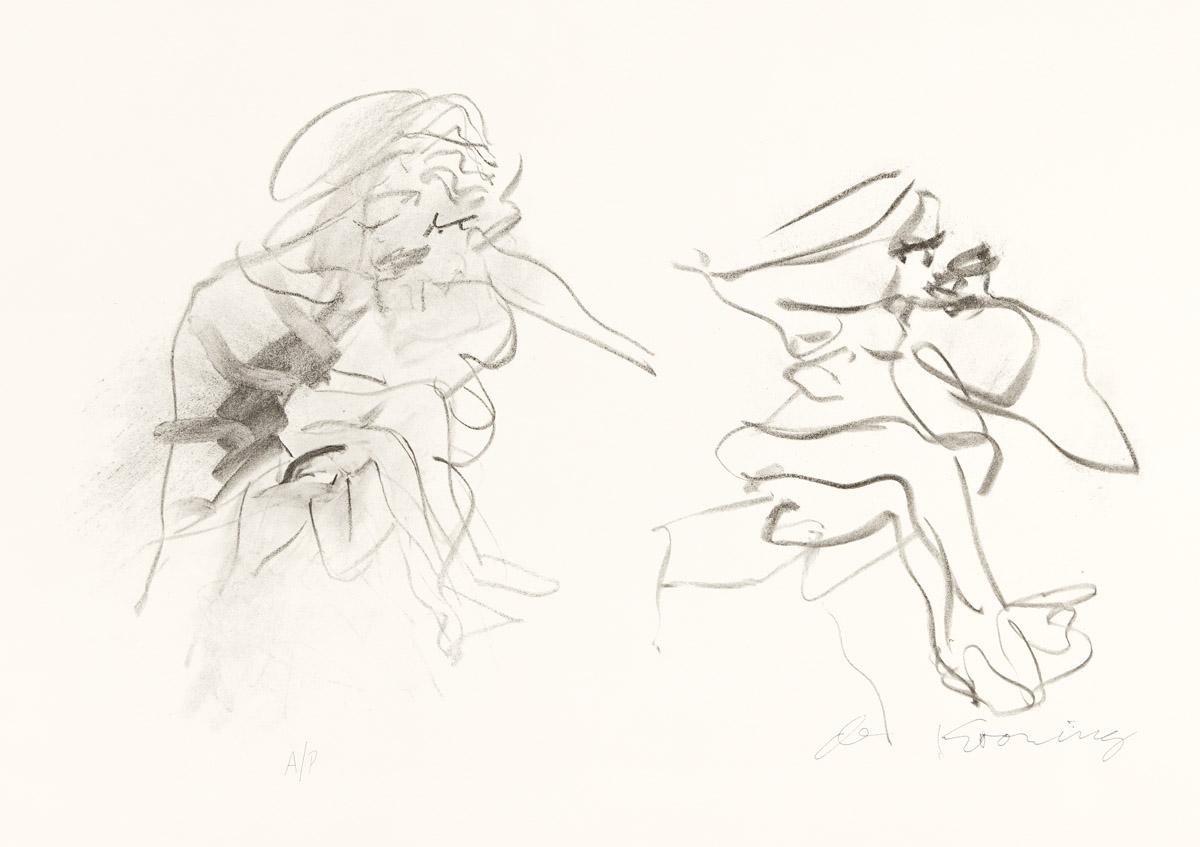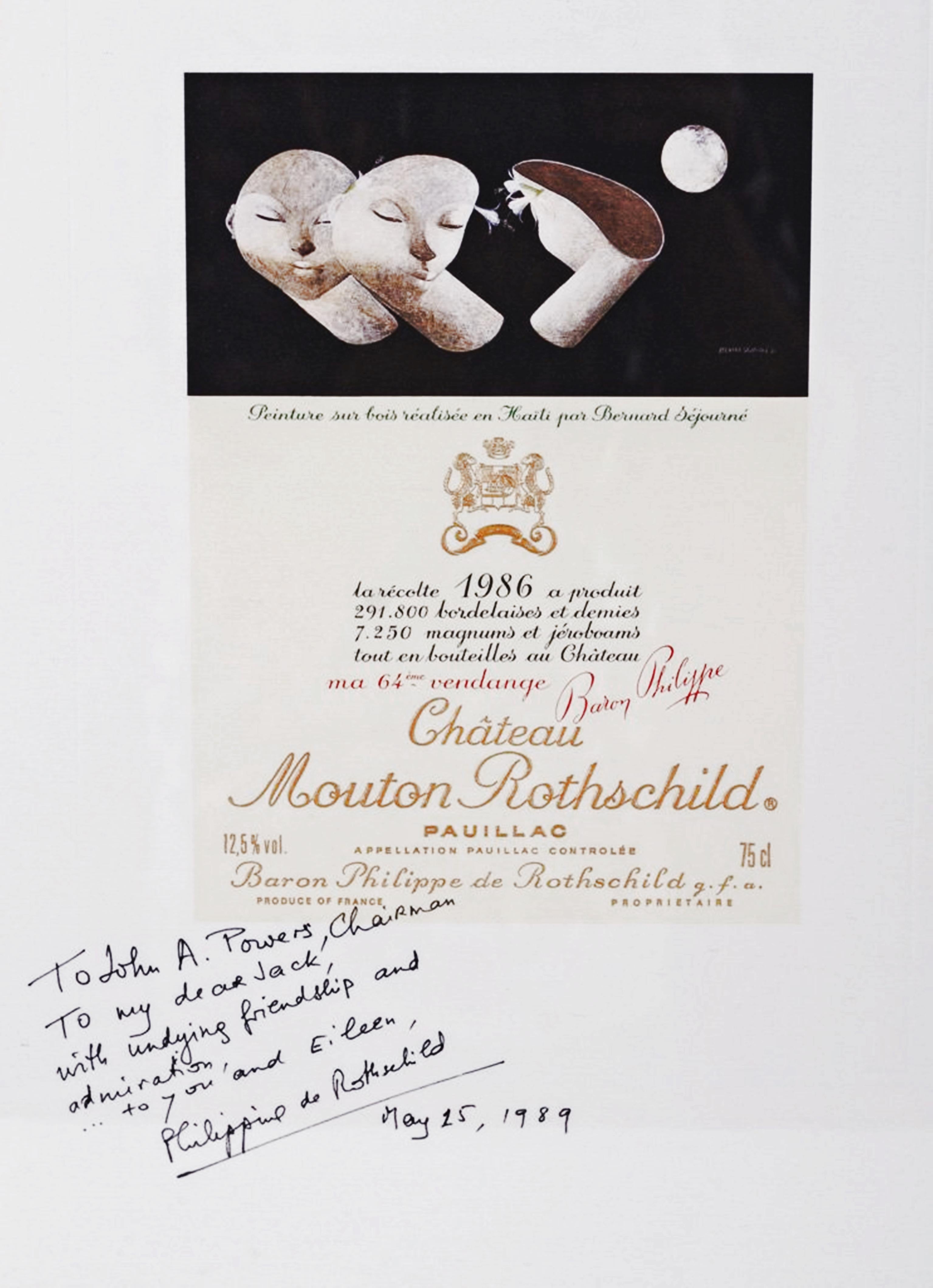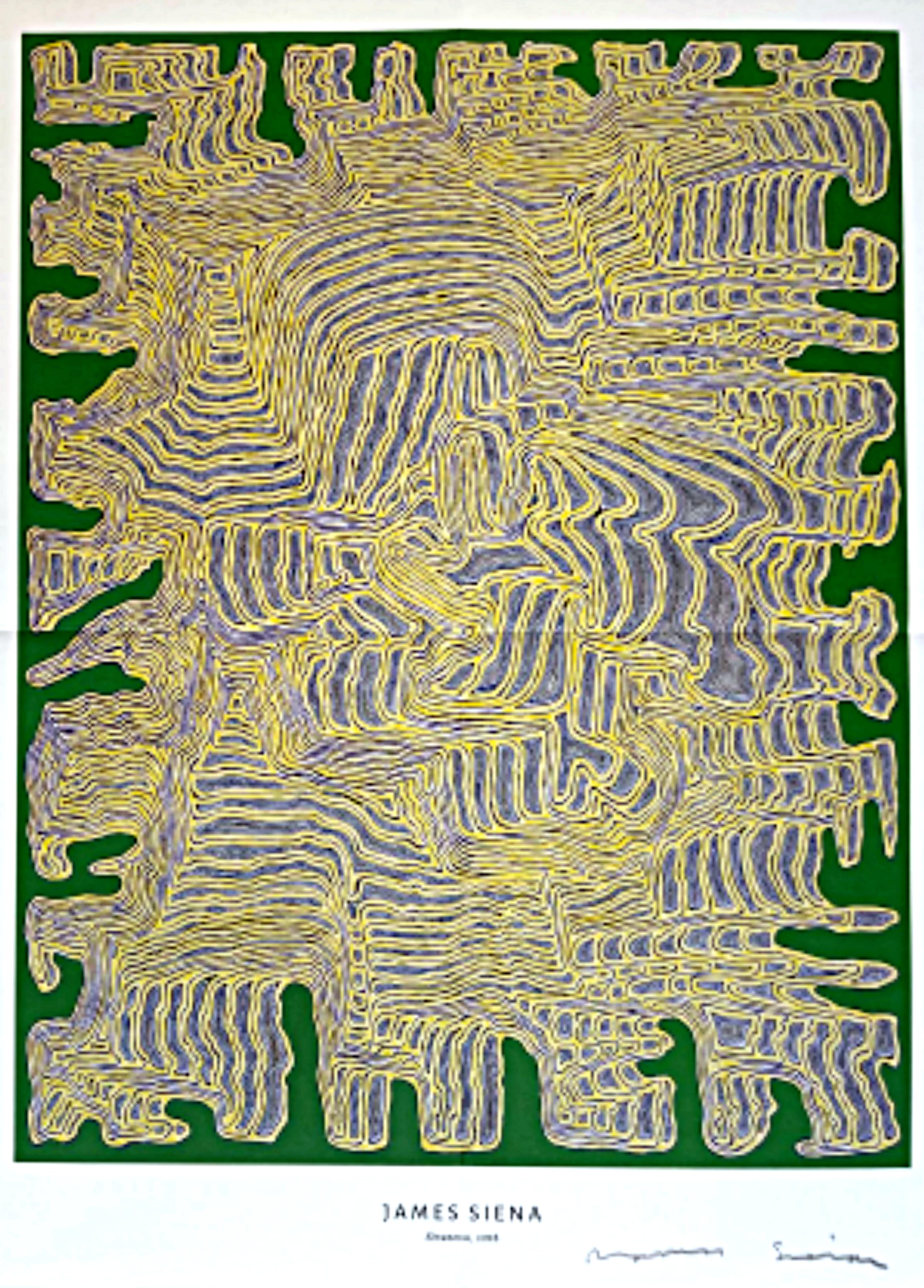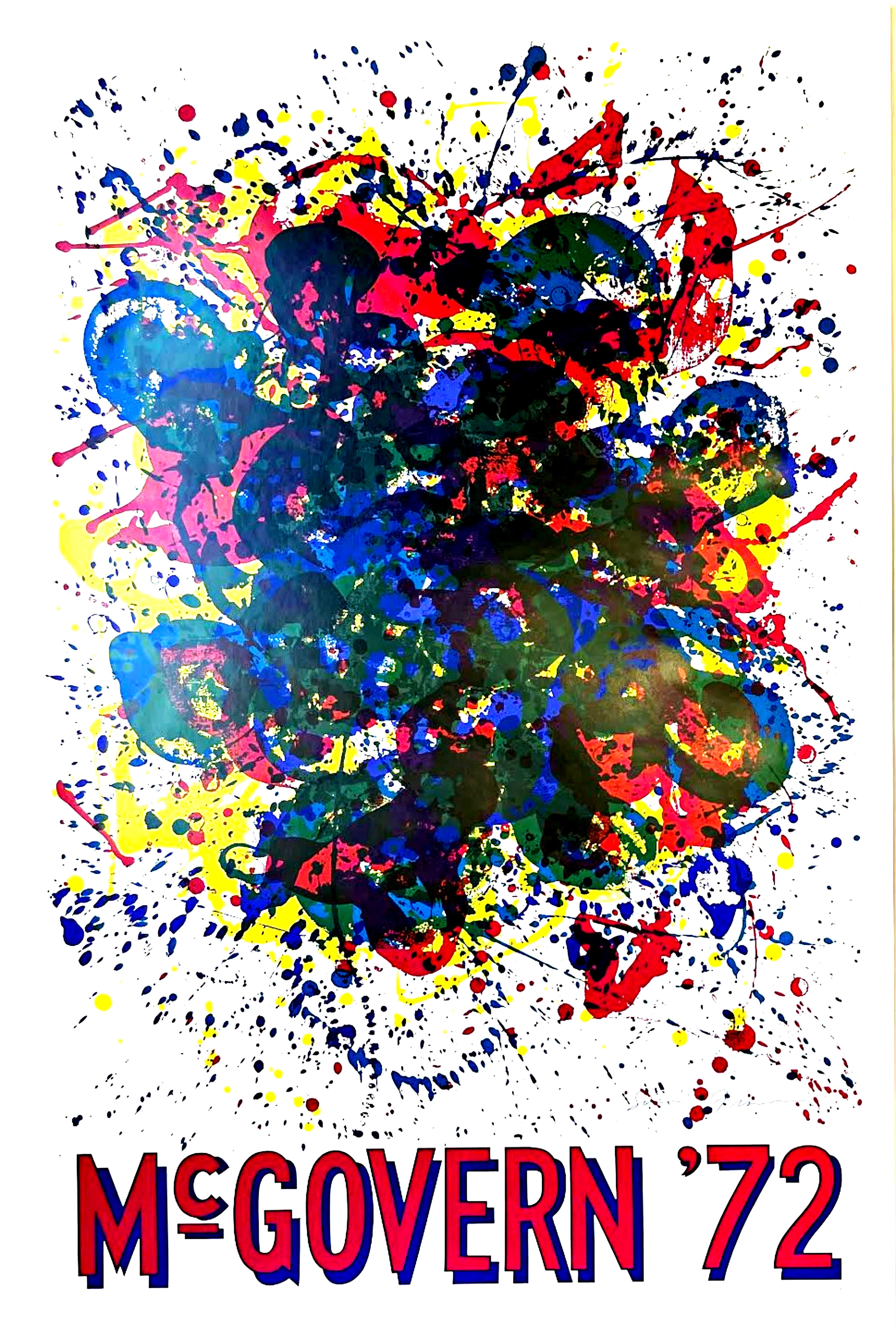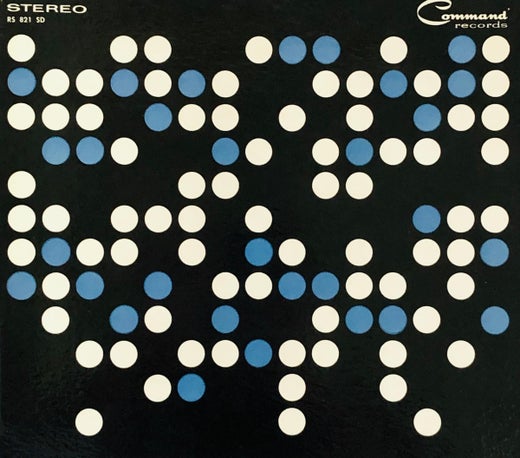Josef AlbersMunich 1972 Olympic Print, Danilowitz 213 Abstract Op Art hand signed & numbered1970
1970
About the Item
- Creator:Josef Albers (1888 - 1976, American, German)
- Creation Year:1970
- Dimensions:Height: 40 in (101.6 cm)Width: 25.5 in (64.77 cm)
- Medium:
- Movement & Style:
- Period:
- Condition:Unframed.
- Gallery Location:New York, NY
- Reference Number:1stDibs: LU1745212955632
Josef Albers
The German-born American painter, writer, and educator Josef Albers was a pioneer of 20th century modernism, and an innovative practitioner of color theory. With his wife, the textile artist and printmaker Anni Albers (1899–1994), he shaped the development of a generation of American artists and designers through his teaching at the experimental Black Mountain College in North Carolina, and later at Yale University School of Art, where he was the chairman of the department of design from 1950–1958. Albers is widely known for his series of prints and paintings "Homages to the Square," which he created between 1950 and 1975. His influential volume on color theory The Interaction of Color was published in 1963.
Albers was born in Bottrop, Germany, and as a young man he studied art education, earning certification from the Königliche Kunstschule in Berlin in 1915. He entered the legendary Bauhaus school in Weimar in 1920. The Bauhaus had been established by Walter Gropius in 1919, in the immediate aftermath of World War I, with the hope that its innovative curriculum would foster connections between architecture, art, and traditional crafts. In 1923 Albers began teaching the Vorkurs, the introductory class in which new students learned to work with each of the key artists’ materials, along with color theory, composition, construction and design.
Albers was a polymath, and the multidisciplinary environment of the Bauhaus was fertile ground for his artistic ambitions. When the school moved from Weimar to Dessau in 1925, he became a full professor, and in addition to glass and metal, he designed typefaces and furniture. While at the Bauhaus, Albers drew inspiration from the work of his colleagues, the color theorist Johannes Itten, and the painter, photographer, and designer László Moholy-Nagy, with whom he co-taught the Vorkurs.
In 1933, the Bauhaus was shut down due to pressure from the Nazi Party, which perceived the school as being sympathetic to communist intellectuals. As Albers’ wife Anni was Jewish, the couple resolved to leave Germany, and settled in rural North Carolina. The architect Philip Johnson helped make arrangements for Albers to join the faculty of Black Mountain College as the head of the painting program, where he remained until 1949. While at Black Mountain, both Josef and Anni Albers became influential mentors to American artists including Ruth Asawa, Cy Twombly, and Robert Rauschenberg, while working alongside fellow professors Buckminster Fuller, John Cage, Merce Cunningham and William de Kooning.
In 1950, Albers joined the faculty of the Yale University School of Art where he would head the newly established Department of Design until his retirement in 1958. In the 1950s, the Alberses began taking trips to Mexico, where the colors and forms of the local art and architecture inspired both artists.
In 1971, Albers became the first living artist whose work was the subject of a solo retrospective at the Metropolitan Museum of Art. Though they worked in different mediums, Josef and Anni Albers’ work shares a fascination with color and geometry. Josef Albers’ compositions from the "Homages to the Square" series, such as Formulation: Articulation Portfolio II Folder 28 (B), from 1972, give deceptively simple shapes a novel vibrance as colors play off of one another. The hues in Articulation Portfolio II Folder 28 (B) work in concert to give the flat surface the distinct appearance of a tunnel or other three-dimensional space; while the form on the left appears to move towards the viewer, the form on the right seems to lead directly into the canvas. Similarly, Anni Albers’ designs for textiles use graphic design to lend a sense of dynamism to flat works. Her Study for Unexecuted Wall Hanging (Bauhaus), from 1984 is a Mondrian-like pattern for a weaving in which different colors alternately recede and advance into the foreground, giving the image a sense of complexity and uncanny depth.
Josef Albers also created works of public art, including a delicate, geometric gold leaf mural called Two Structural Constellations for the lobby of the Corning Glass building in New York City in 1959. He designed a work called Two Portals for the lobby of the Time & Life Building in 1961, in which which and brown bands move towards two square panels made of bronze. Walter Gropius invited Albers to create a piece for the Pan Am Building, which he was designing with the architectural firm of Emery Roth & Sons. Albers reworked an existing glass piece from his Bauhaus days called City, and, fittingly, renamed it Manhattan.
Find a collection of authentic Josef Albers art on 1stDibs.
- ShippingRetrieving quote...Ships From: New York, NY
- Return PolicyA return for this item may be initiated within 1 day of delivery.
- Glaspalast Edition poster, Munich, Germany 1996 (Hand Signed by Sean Scully)By Sean ScullyLocated in New York, NYSean Scully Munich 1996 (Hand Signed), 2001 Offset Lithograph poster Hand signed and dated by Sean Scully in 2018 Boldly signed in black marker on the recto. Hand signed by Sean Scul...Category
Early 2000s Abstract Abstract Prints
MaterialsLithograph, Offset, Ink, Permanent Marker
- Chateau Mouton Rothschild Wine Label Signed & inscribed Philippine de RothschildBy Bernard SéjournéLocated in New York, NYBernard Séjourné Chateau Mouton Rothschild Wine Label (Hand Signed & Inscribed), 1989 Wine Label Print Signed “To John A. Powers, Chairman, To my dea...Category
1980s Abstract Abstract Prints
MaterialsLithograph, Offset
- James SIena at PACE poster Hand signed by James Siena complex linear abstractionBy James SienaLocated in New York, NYJames Siena at PACE Gallery, 2019 Offset lithograph exhibition invitation (Hand signed by James Siena) 19 1/2 × 14 1/2 inches Unframed This exquisite fold...Category
2010s Abstract Geometric Abstract Prints
MaterialsOffset, Graphite, Pencil, Lithograph
- Offset lithograph poster (Signed by both Helen Frankenthaler and Aaron Copland)By Helen FrankenthalerLocated in New York, NYHelen Frankenthaler Pro Musica's Contemporary American Choral Music (Hand signed by both Helen Frankenthaler and Aaron Copland), 1982 Offset lithograph poster (Hand signed by Helen F...Category
1980s Abstract Expressionist Abstract Prints
MaterialsInk, Lithograph, Offset
- Sam Francis McGovern '72 Poster (Hand signed by Sam Francis) Abstract lithographBy Sam FrancisLocated in New York, NYSam Francis McGovern '72 Poster (Hand signed by Sam Francis), 1972 Photo offset poster (hand signed by Sam Francis) Signed in blue ink on the front by Sam Francis with Sam Francis co...Category
1970s Abstract Expressionist Abstract Prints
MaterialsOffset, Lithograph
- Lt Ed. Lithograph from the Deluxe (Hand Signed) 1984 Olympic Committee portfolioBy Sam FrancisLocated in New York, NYSam Francis Untitled Abstract Expressionist print for the 1984 Olympics, 1982 Offset Lithograph on Parsons Diploma Parchment paper, hand signed with COA from publisher for Olympic Co...Category
1980s Abstract Expressionist Abstract Prints
MaterialsLithograph, Offset, Pencil
- Untitled (Two Figures)By Willem de KooningLocated in New York, NYA very good impression of this scarce offset lithograph on cream wove paper. Artist's proof, aside from the edition of 100. Signed in ink, lower right, and inscribed "A/P" in pencil,...Category
1970s Abstract Expressionist Abstract Prints
MaterialsLithograph, Offset
- Vintage Agam American Portrait Abstract Modernist Offset Print PosterBy Yaacov AgamLocated in Surfside, FLYaacov Agam, Israeli (b. 1928) Offset Print Poster: Birth of a Flag: An American Portrait 1776-1976 Biographical info: The son of a rabbi, Yaacov Agam can trace his ancestry back s...Category
20th Century Abstract Abstract Prints
MaterialsOffset
- ZERO Gruppe, Original Exhibition Poster, 1970, Galerie Denise Rene Hans MayerLocated in Hamburg, DEOriginal poster for the exhibition "ZERO in Krefeld" at Galerie Denise Rene Hans Mayer from 10 October to 14 November 1970. The ZERO artist group, founded in the late 1950s in Germ...Category
20th Century Abstract Abstract Prints
MaterialsOffset
- Large Johnny Friedlaender Poster Print No TextBy Johnny FriedlaenderLocated in Surfside, FLJohnny Friedlaender (26 December 1912 – 18 June 1992) was a leading 20th-century artist, whose works have been exhibited in Germany, France, Netherlands, Italy, Japan and the United States. He has been influential upon other notable artists, who were students in his Paris gallery. His preferred medium of aquatint etching is a technically difficult artistic process, of which Friedlaender has been a pioneer. Gotthard Johnny Friedlaender was born in Pless (Pszczyna), Prussian Silesia, as the son of a pharmacist. He was graduated from the Breslau (Wrocław) high school in 1922 and then attended the Academy of Arts (Akademie der Bildenden Kunste) in Breslau, where he studied under Otto Mueller. He graduated from the Academy as a master student in 1928. In 1930 he moved to Dresden where he held exhibitions at the J. Sandel Gallery and at the Dresden Art Museum. He was in Berlin for part of 1933, and then journeyed to Paris. After two years in a Nazi concentration camp, he emigrated to Czechoslovakia, where he settled in Ostrava, where he held the first one-man show of his etchings. In 1936 Friedlaender journeyed to Czechoslovakia, Switzerland, Austria, France and Belgium. At the Hague he held a successful exhibition of etchings and watercolours. He fled to Paris in 1937 as a political refugee of the Nazi regime with his young wife, who was an actress. In that year he held an exhibition of his etchings which included the works: L ‘Equipe and Matieres et Formes. From 1939 to 1943 he was interned in a series of concentration camps, but survived against poor odds. After freedom in 1944 Friedlaender began a series of twelve etchings entitled Images du Malheur with Sagile as his publisher. In the same year he received a commission to illustrate four books by Freres Tharaud of the French Academy. In 1945 he performed work for several newspapers including Cavalcade and Carrefour. In the year 1947 he produced the work Reves Cosmiques and in that same year he became a member of the Salon de Mai, which position he held until 1969. In the year 1948 he began a friendship with the painter Nicolas de Staël and held his first exhibition in Copenhagen at Galerie Birch. The following year he showed for the first time in Galerie La Hune in Paris. After living in Paris for 13 years, Friedlaender became a French citizen in 1950. Friedlaender expanded his geographic scope in 1951 and exhibited in Tokyo in a modern art show. In the same year he was a participant in the XI Trienale in Milan, Italy. By 1953 he had produced works for a one-man show at the Museum of Neuchâtel and exhibited at the Galerie Moers in Amsterdam, the II Camino Gallery in Rome, in São Paulo, Brazil and in Paris. He was a participant of the French Italian Art Conference in Turin, Italy that same year. Friedlaender accepted an international art award in 1957, becoming the recipient of the Biennial Kakamura Prize in Tokyo. In 1959 he received a teaching post awarded by UNESCO at the Museum of Modern Art in Rio de Janeiro. By 1968 Friedlaender was travelling to Puerto Rico, New York City and Washington, D.C. to hold exhibitions. That year he also purchased a home in the Burgundy region of France. 1971 was another year of diverse international travel including shows in Bern, Milan, Paris, Krefeld and again New York. In the latter city he exhibited paintings at the Far Gallery, a venue becoming well known for its patronage of important twentieth-century artists. From his atelier in Paris Friedlaender instructed younger artists who themselves went on to become noteworthy, among them Arthur Luiz Piza, Brigitte Coudrain...Category
Mid-20th Century Modern Abstract Prints
MaterialsOffset, Screen
- Anni Albers, ST - Original Screen Print from 1971, Geometric AbstractionBy Anni AlbersLocated in Hamburg, DEAnni Albers (1899-1994) ST, 1971 Medium: Screenprint on cardboard Dimensions: 83 × 62 cm (32 7/10 × 24 2/5 in) Edition: Not signed, not numbered outside the edition of 150. Condition...Category
20th Century Abstract Abstract Prints
MaterialsScreen
- 'E Pluribus Unum', Modernist Silk Screen, Walt Disney, San Miguel de AllendeBy Ross WetzelLocated in Santa Cruz, CASigned lower right, in pencil, 'Ross Wetzel' (American, 1917 - 2013), titled lower left, 'E Pluribus Unum' and with number and limitation, '118/300'. Paper dimensions: 14 x 21 inches. Born in Chicago, Ross Wetzel was an avid art student through high school, and then enrolled- with his future wife and fellow artist, Janice- at the American Academy of Art in Chicago. He was soon working for Walt Disney Productions, taking lead production roles in the creation of such Disney classics as Pinocchio, Fantasia and Bambi. During the Second World War, he served with the Motion Picture Unit of the First Army Air Corp under Ronald Reagan, creating training films for fighter pilots and bombers and working beside actors including Alan Ladd and Clark Gable. After the War, Ross and Janice started a serigraphy business, which came to be known as Ross Wetzel Studios creating animated commercials and print advertisements for companies such as Kellogg's, Kleenex and Continental Airlines that featured such characters as Tony the Tiger and Toucan Sam. Ross was also hired to illustrate one of the first renderings of Smokey the Bear...Category
1970s Abstract Abstract Prints
MaterialsPaper, Screen
Recently Viewed
View AllRead More
Get to Know the Artists Who Led the Op Art Movement
In the 1960s and '70s, the hypnotic creations of Op artists went mainstream and influenced the look of pop culture.
Welcome (Back) to the Wild, Wonderful World of Walasse Ting
Americans are rediscovering the globe-trotting painter and poet, who was connected to all sorts of art movements across a long and varied career.

